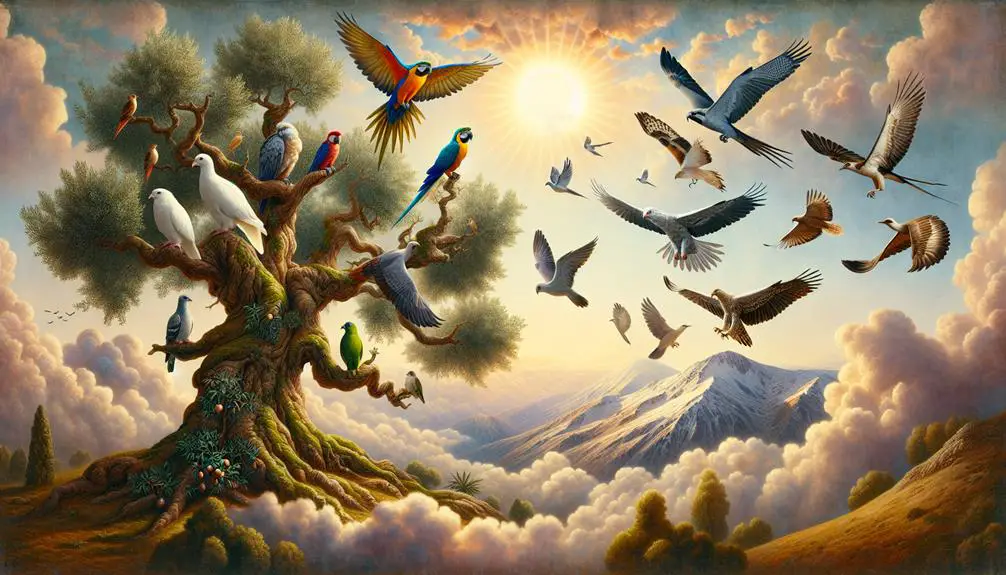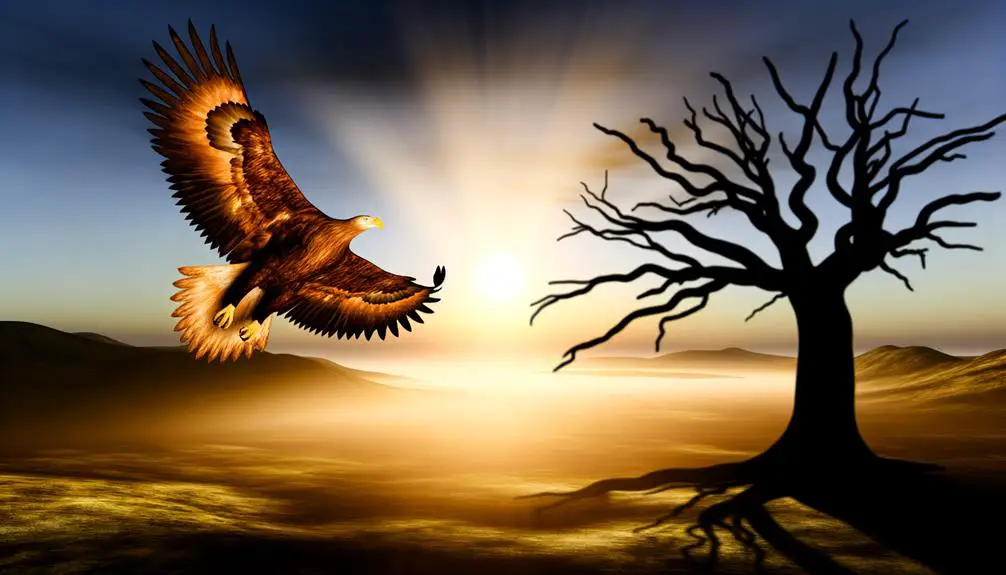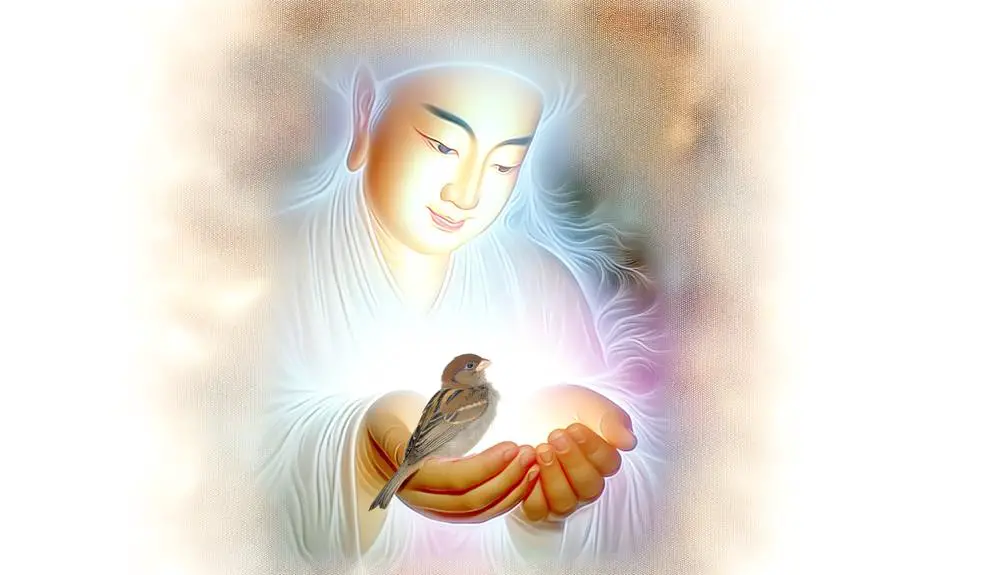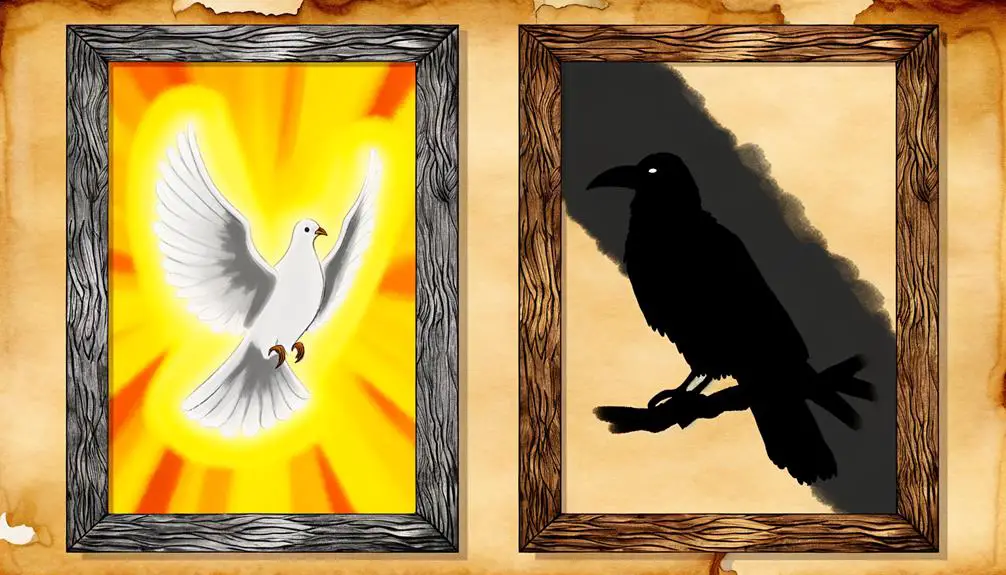Marvel at how birds in the Bible symbolize divine messages and mysteries, inviting you to explore deeper spiritual insights.

Significance of Birds in the Bible
Did you know that birds are mentioned over 300 times in the Bible?
You'll find that each reference carries a unique symbolism that has guided interpretations and teachings across centuries.
From the dove representing the Holy Spirit to the eagle symbolizing strength and renewal, birds play a pivotal role in biblical narratives.
Consider the raven's act of provision or the sparrow's illustration of divine care; these stories aren't just about the animals but about deeper moral and spiritual lessons.
Let's explore together what these feathered creatures reveal about faith, providence, and purity in the biblical context.
Key Takeaways
- Birds in the Bible symbolize various spiritual themes, from the Holy Spirit to divine care and renewal.
- Specific birds like doves, ravens, eagles, and sparrows carry distinct symbolic meanings, including peace, provision, strength, and divine watchfulness.
- The symbolism of birds is enriched by cultural and ritual significance, reflecting themes of resurrection, vigilance, and purity in different traditions.
- Levitical dietary laws on birds underscore health, purity, and the interplay between physical and spiritual realms, marking sacred boundaries.
Symbolism of the Dove

Throughout the Bible, the dove emerges as a potent symbol of peace, purity, and the Holy Spirit, embodying messages of divine significance and human aspiration. This bird's representation transcends mere imagery, becoming a conduit through which profound theological and ethical meanings are conveyed. When you delve deeper into the scriptural narratives, the dove's symbolic resonance is multifaceted, yet consistently aligns with themes of renewal, hope, and divine presence.
One of the most striking instances involves the olive branch carried by a dove back to Noah, signaling the end of the flood and the restoration of peace between God and humanity. This episode doesn't just highlight the dove as a peace emblem; it intricately weaves the bird with the concept of a fresh start, intertwining it with the olive branch, a symbol of life and prosperity. The imagery is rich and layered, suggesting not just the cessation of God's wrath but also the promise of new beginnings and a renewed relationship with the divine.
Moreover, the dove's association with the Holy Spirit, especially in the New Testament, imbues it with a profound spiritual significance. During the baptism of Jesus, the descent of the Holy Spirit in the form of a dove illustrates the purity, gentleness, and divinity of God's spirit, reinforcing the bird's emblematic role as a bearer of peace and divine favor. This depiction not only enriches the dove's symbology but also deepens the understanding of the Holy Spirit's role in Christian theology.
Ravens: Providers in Desperation

While the dove symbolizes peace and divine favor, the raven's role in the Bible showcases its essential function as a provider during times of desperation and need. The narrative of the raven, often overshadowed by the more favorably viewed dove, demands a closer examination for its profound symbolic significance and the insights it offers into raven intelligence.
In the biblical context, the raven's first notable appearance is as Noah's messenger, sent out to assess the post-flood world. This task alone hints at the raven's intelligence and utility, traits recognized and utilized by Noah amidst uncertainty. The choice of the raven for this mission underlines not just its natural capabilities but its symbolic role as a harbinger of new beginnings, albeit through a lens of pragmatism and survival.
The emblematic scene where ravens provide for the prophet Elijah during a time of famine further cements the bird's role as a provider in desperation. This act of delivering food to Elijah not only exemplifies the raven's intelligence but also illustrates a divine intervention mechanism, where the least expected of God's creatures becomes a vessel of sustenance and survival. It's a poignant reminder of the unexpected ways in which provision and blessings can manifest, especially in times of dire need.
Analyzing these biblical episodes reveals a layered understanding of ravens: they're not merely background characters but pivotal agents chosen for tasks that require a unique blend of intelligence, resilience, and capability. Their inclusion in these narratives speaks volumes about their significance, challenging readers to reconsider the raven's role from mere birds to symbolic messengers of provision and hope in times of desperation.
Eagles: Metaphors for Renewal

In biblical literature, eagles symbolize divine intervention and the promise of renewal, serving as powerful metaphors that encapsulate a profound spiritual rejuvenation. This imagery, steeped in ancient texts, invites you to delve deeper into the spiritual symbolism of the eagle, especially concerning its strength and the sense of soaring freedom it embodies.
Eagles in the Bible aren't merely birds but are emblematic of a higher power that rejuvenates and empowers believers. The eagle's strength is frequently mentioned, symbolizing God's overpowering support for those who are weary. This strength allows for a form of soaring freedom, a liberation from the shackles of earthly burdens, and an elevation towards spiritual enlightenment.
Consider these aspects:
- Eagle's strength: Represents the robust and unwavering support provided by divine forces, offering hope and resilience.
- Soaring freedom: Symbolizes the liberation from worldly troubles and the ascent into a more profound, spiritual realm.
- Renewal: The process of being made new, akin to how eagles are believed to renew their strength and youth.
- Divine intervention: Eagles are a sign of God's direct involvement in the believer's life, guiding and protecting.
- Spiritual rejuvenation: The ultimate goal of the believer's journey, where one is refreshed and revitalized through faith.
Through these symbols, you're invited to reflect on the eagle's significance beyond its physical attributes, exploring its role as a divine messenger of renewal and hope. The eagle's strength and its soaring freedom offer a metaphorical lens through which to view one's spiritual journey—highlighting the transformative power of faith and the promise of renewal that it brings.
Sparrows and Divine Care

Sparrows, though small and often overlooked, embody the profound biblical principle of divine care for all creatures, significant and insignificant alike. Their presence throughout scripture isn't merely incidental; it's emblematic of a wider theological assertion that every aspect of creation, no matter how seemingly minor, is under the watchful eye of the divine. This notion is particularly resonant when considering sparrow migration—a phenomenon that showcases not only the resilience of these creatures but also the meticulous order within which they operate. This orderly migration underscores a belief in a universe governed by divine providence, where even the smallest sparrow's journey is of concern.
Moreover, the feather symbolism attached to sparrows further deepens their biblical significance. Feathers, often a metaphor for protection and care, align with the narrative of divine oversight. This imagery suggests that just as feathers shield and warm the bird, so too does divine care envelop those who might feel lost or insignificant. The sparrow, with its modest appearance yet remarkable journey, becomes a powerful symbol of hope and reassurance for believers. It serves as a reminder that in the eyes of the divine, there are no insignificant beings, only unique creations worthy of care and attention.
Thus, through the lens of sparrow migration and feather symbolism, one gains a deeper understanding of the biblical message of universal care. The sparrow's narrative in scripture isn't just a lesson on avian habits; it's a profound exploration of the nature of divine watchfulness and care extended to all corners of creation.
The Rooster's Prophetic Crow

The rooster's prophetic crow, mentioned in the Bible, serves as a poignant reminder of human frailty and divine omniscience, marking a pivotal moment that intertwines destiny with a call to awareness. This event, deeply embedded in the Christian narrative, illuminates the interplay between free will and divine foreknowledge, particularly through the lens of Peter's denial.
Cockcrow interpretations have varied, but the essence remains: a signal of a new dawn and, in this context, a new understanding. The rooster's crow, echoing at the moment of Peter's third denial of Jesus, underscores the fragility of human resolve in the face of fear and uncertainty. This episode isn't merely a recount of weakness; it's a complex tapestry of prophecy, human nature, and the opportunity for redemption.
Consider these elements:
- Symbolism: The rooster's crow symbolizes both betrayal and the onset of a new beginning, urging a reflection on the nature of repentance.
- Divine Foreknowledge: This event highlights the coexistence of divine prediction and human free will, challenging simplistic interpretations of predestination.
- Human Frailty: Peter's denial, juxtaposed with the rooster's crow, serves as a narrative focal point for exploring themes of fear, regret, and eventual restoration.
- Cultural Context: Understanding the significance of the rooster in ancient cultures adds depth to its symbolic role in this narrative.
- Moral Insight: This biblical moment offers a profound moral lesson on vigilance, repentance, and the possibility of forgiveness.
In analyzing the rooster's crow and Peter's denial, one encounters a rich tapestry of themes that invite contemplation on the human condition, divine insight, and the path to redemption.
Unclean Birds and Purity Laws

You'll find that the Levitical dietary rules categorize certain birds as unclean, a distinction that not only affects diet but also weaves into the broader fabric of ritual purity.
This classification mirrors a complex interplay between the physical and the spiritual, illustrating how purity laws symbolize deeper theological truths.
Levitical Dietary Rules
Within Levitical law, specific birds are designated as unclean for consumption, reflecting intricate purity regulations and their significance in ancient dietary practices. These distinctions likely had health implications, considering the risks associated with consuming certain species. Moreover, they underscored cultural practices, embedding a sense of communal identity and spiritual obedience.
Consider the following unclean birds, as outlined:
- Eagles
- Vultures
- Owls
- Hawks
- Ravens
This list isn't exhaustive, but it highlights a pattern: many of these birds are carrion eaters, which could pose health risks. The Levitical dietary rules serve not just a spiritual purpose but also a practical one, aiming to protect the community's health while reinforcing a collective cultural and religious identity.
Symbolism of Purity
In analyzing the concept of purity within biblical texts, it becomes evident that the designation of certain birds as unclean is not merely about dietary laws but deeply intertwined with broader purity regulations and their symbolic significance. These feathered messengers serve as celestial signs, marking the boundary between the sacred and the profane.
Bird Type |
Symbolic Meaning |
|---|---|
Clean Birds |
Purity, Holiness |
Unclean Birds |
Impurity, Sin |
Through this lens, unclean birds symbolize the separation from holiness, guiding believers in their spiritual journey towards purification. Conversely, clean birds are celebrated as embodiments of purity, acting as symbols of the aspirational state of cleanliness required by the faithful. This duality highlights the intricate role of birds as symbols within the biblical narrative, underpinning the profound interplay between the natural world and theological concepts.
Frequently Asked Questions
How Do Birds in the Bible Reflect the Cultural and Religious Beliefs of Other Ancient Civilizations?
You'll find that birds serve as a fascinating bridge between the spiritual beliefs of ancient civilizations and those found in the Bible. Through ancient myths comparison, it's evident birds were revered symbols, embodying divine messages across cultures.
Bird divination practices, prevalent in various societies, highlight a shared reverence and belief in birds as messengers of gods or omens. This similarity underscores a deep, cross-cultural spiritual significance attributed to birds throughout history.
Are There Any Specific Biblical Stories Where Birds Played a Crucial Role That Are Not Commonly Discussed or Known?
You mightn't be familiar with some lesser-known biblical stories where birds played pivotal roles. Beyond the Raven's provision and the Dove's peace, these narratives delve deep into symbolism.
The raven, for instance, is often overlooked despite its role in sustaining Elijah during famine (1 Kings 17).
Similarly, the dove, symbolizing peace, carries lessons beyond Noah's story, embodying hope and renewal in contexts that are rarely highlighted.
These stories offer profound insights into faith and resilience.
How Have Interpretations of Birds' Significance in the Bible Evolved With Modern Christian Theology?
In modern Christian theology, interpretations of birds have evolved significantly. Feather symbolism, once seen merely as divine messages, now often reflects personal spiritual journeys or the Holy Spirit's guidance.
Similarly, avian migration, previously a testament to God's creation, is increasingly viewed as a metaphor for faith transitions and the believer's path. These shifts highlight a deeper, more personal connection to these symbols in contemporary faith discussions.
In What Ways Do Non-Canonical Texts or Apocryphal Writings of Christianity and Judaism Shed Light on the Symbolism of Birds Not Covered in the Main Biblical Narratives?
You'll find that apocryphal texts reveal layers to birds' mysticism not seen in canonical scriptures. These writings, often overlooked, provide a richer palette of symbolic meanings and narratives. They delve into the spiritual and metaphorical roles of birds, offering insights beyond the traditional narratives.
Apocryphal influences highlight a broader spiritual ecosystem, where birds play pivotal roles in conveying divine messages and embodying spiritual principles not fully explored in mainstream texts.
How Do the Depictions of Birds in the Bible Influence Contemporary Environmental Stewardship and Animal Conservation Efforts Within Christian Communities?
Bird depictions in the Bible inspire you to engage in environmental stewardship and animal conservation, especially within Christian communities.
You're motivated to support bird protection laws and integrate ecological themes into sermons, reflecting a deep-seated value for all of creation.
These actions aren't just about adherence to faith; they're a practical expression of biblical teachings, showing how ancient texts guide contemporary efforts to protect and conserve the natural world, including its avian inhabitants.
Conclusion
In analyzing the biblical portrayal of birds, you'll find these winged creatures aren't merely part of the background; they're profound symbols.
The dove embodies peace, while ravens represent God's provision in times of need.
Eagles illustrate spiritual renewal, symbolizing hope and strength.
Sparrows highlight God's meticulous care, and the rooster's crow serves as a prophetic warning.
Meanwhile, unclean birds emphasize the importance of purity laws.
Collectively, these portrayals underscore a complex tapestry of divine messages, intertwining natural elements with spiritual teachings.



Sign up